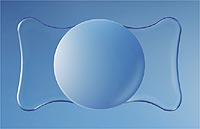Microlenses boost progress of bimanual technique in cataract surgery
|
ROME – Both the ThinOptX and the Acri.Tec AcriSmart ultrathin IOLs perform well, according to a surgeon who implanted both models during the live surgery session of the European Society of Cataract and Refractive Surgeons winter meeting here.
“They give microincision cataract surgery a reason for existing. The situation has reversed, because when we first developed microincision cataract surgery, all lenses were too big to be implanted without enlarging the incision. Now we have the lenses, but what has to be improved is the surgical technique, which is far from being perfect,” said Matteo Piovella, MD, of Monza, Italy.
AcriSmart: slim, flexible
Though they share the capability of being implanted through a 1.5-mm incision, the two lenses are different in conception.
The AcriSmart is more like a traditional acrylic lens, but the flexible material and the geometry — one-third less compared to normal lenses — make it easy to fold into the injector, independent of the dioptric power. Dr. Piovella, who performed eight of these implants, was able to inject a 30 D AcriSmart IOL through a 1.5-mm incision.
“The lens glides smoothly through the injector, and unfolds slowly and steadily with perfect control into the capsular bag. Thanks to its small size, it can also be easily directed into the bag through a miotic pupil,” he said.
ThinOptX: multicentric design
The ThinOptX is a hydrophilic, rollable lens with a novel multicentric design. One surface of the lens is lathe-cut to retain a continuous curvature and/or orientation as in traditional lenses, while the second surface is divided into a series of concentric rings with a slightly different curvature gradient.
“By distributing the total lens power within these rings, the overall thickness of the lens can be greatly reduced. The overall thickness is about one-tenth compared to normal lenses, and the IOL can be rolled into the injector in a very uniform pattern,” said Dr. Piovella, who has implanted 23 ThinOptX IOLs in his patients.
To increase the foldability of the lens, he soaks it into a warm saline solution before rolling it. Like in a thermoplastic lens, the material becomes softer and suppler.
Once in the capsular bag, the lens unfolds gently in about 20 to 30 seconds.
“Just the right time to position it well in the bag and perform the conclusive surgical maneuvers,” Dr. Piovella said.
An additional property of the ThinOptX might be the ability to slightly accommodate inside the eye.
“This effect was not intentionally introduced in the manufacturing of the lens. It’s something that has been seen in some patients and might be due to the fact that the lens is so thin and light that it moves naturally inward and backward when stimulated by the movements of the ciliary muscle,” Dr. Piovella explained. This property of the lens is now under investigation.
|
|
Improving bimanual surgery
The technology of the ultrathin ThinOptX and the AcriSmart lenses will doubtless revolutionize the IOL market, Dr. Piovella said. Other manufacturers are preparing their prototypes and it may not be long before these lenses are commercially available.
“In the meantime, we must refine the technique and the surgical instruments for microincision cataract surgery. Until about 2 months ago we didn’t even have a surgical knife specially designed for 1.5-mm incisions,” Dr. Piovella noted.
The trend toward microincision began with the introduction of Dodick Photolysis, and continued with the low-ultrasound phaco using sleeveless microtips.
“Removing the sleeve from the phaco tip has been a very important step forward,” said Dr. Piovella, who believes that low-ultrasound phaco rather than laser will be the future of cataract surgery.
In his opinion, bimanual technique has great potential, although it is more difficult, more time-consuming and has a longer learning curve than standard cataract surgery. The latter, he said, has reached very high levels and in expert hands requires about 10 minutes to be performed.
“So far, bimanual technique hasn’t been particularly competitive,” he said. “We lack confidence, we don’t have the proper instruments and every maneuver takes us more time than it ought to. The overall surgical time can be double that of a normal procedure. However, with more experience and the development of an appropriate surgical armamentarium, we can improve bimanual technique and benefit from the many advantages of microincision surgery.”
For Your Information:
- Matteo Piovella, MD, can be reached at Centro Microchirurgia Ambulatoriale, Via Donizetti 24, 20052 Monza, Italy; +(39) 03-938-9498, fax: +(39) 03-9230-0964; e-mail: piovella@piovella.com. Ocular Surgery News could not confirm whether Dr. Piovella has a direct financial interest in any of the products mentioned or if he is a paid consultant for any company mentioned.
- ThinOptX, manufacturer of the ThinOptX IOL, can be reached at P.O. Box 784, Abingdon, VA 24212 U.S.A.; +(1) 276-623-2258; fax: +(1) 276-623-5661; e-mail: ThinOptX@naxs.net; Web site: www.thinoptx.com.
- Acri.Tec GmbH, manufacturer of the AcriSmart IOL, can be reached at Lindenstrasse 22/24, D-16548 Glienicke b. Berlin, Germany; +(49) 330-56610-0; fax: +(49) 330-56610-10; e-mail: info@acritec.de.



